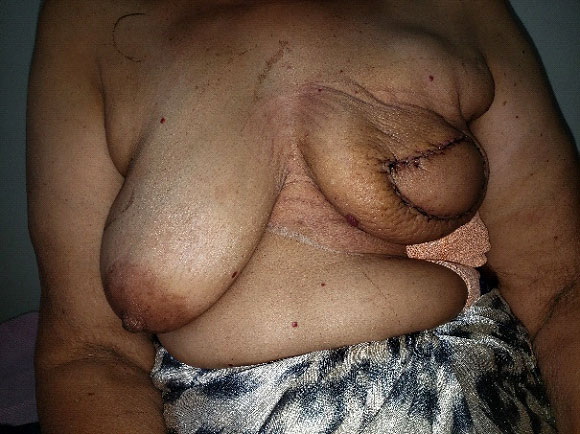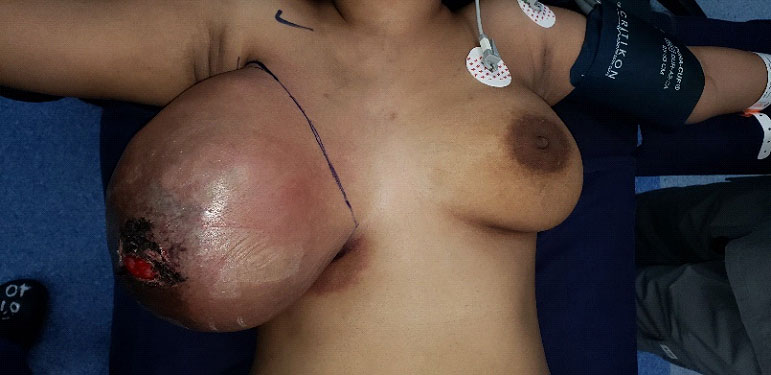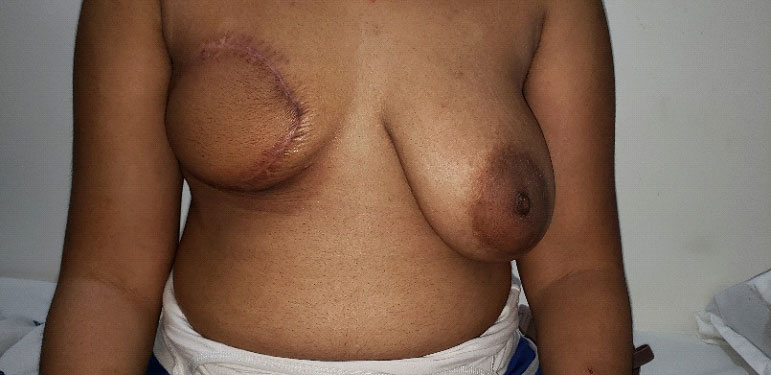Introduction
Post mastectomy breast reconstruction is an integral part of breast cancer management. The breast is an important organ for a woman’s body image. Despite the benefits of psychosocial well-being, positive body image, and improved quality of life, very few women in India undergo breast reconstruction after mastectomy. Only one percent of women undergoing mastectomies receive breast reconstruction although breast cancer is the most common cancer accounting for 14% of all new cases of malignancies.
Case History and Management
Case Discussion
The demography of women affected by breast cancer in India is different from the western world. The average age of affected women is a decade younger than in the west. Women in their mid-forties, premenopausal, and living in urban areas tend to have a higher risk of developing breast cancer. In a study from Tata Memorial Hospital of young women with a median age of 36, less than 10% underwent reconstruction following mastectomy. Even in a dedicated tertiary cancer hospital with a multidisciplinary team, the reconstruction percentage is low. The reasons are reluctance, irrational fear of delay in treatment, additional cost, and other logistic issues.
Surgical Treatment Modalities
The gold standard in breast cancer surgery remains total mastectomy giving the best chances of disease-free survival. Mastectomy has evolved from the era of Halstead’s radical mastectomy to total and simple mastectomy and in the recent years limited to lumpectomy for early cancers.
Total mastectomy usually refers to resection of breast tissue, skin, and the nipple-areola complex through a wide elliptical incision with primary closure or reconstruction with axillary node or sentinel node dissection. Simple Mastectomy is a total mastectomy without axillary node or sentinel node dissection.
Lately, Breast Conservation Surgery (BCS), has proved to be oncologically sound for stage 1 and stage II breast cancers with minimal scar and less physical and psychological trauma to the patient. Lumpectomy with axillary dissection followed by RT for early-stage diseases showed overall disease free survival rates equal to mastectomy.
Reconstruction Methods Following Mastectomy
Reconstruction is necessary when the excision in BCS exceeds 20% of breast volume. Oncoplastic Breast Surgery (OPS) is removal of lump with wider excision margins without compromising aesthetic outcomes. In such partial mastectomy defects the reconstruction is based on either volume displacement wherein the remaining breast tissue is rearranged to fill the defect or volume replacement with local, regional or microvascular free flaps. Autologous fat grafting is done wherein fat is aspirated from the lower abdomen or thigh and injected into the breast to fill the defect. Implant-based reconstructions are also considered if there is a paucity of tissues. Association of Breast Surgeons of India’s “Practical Consensus Statement” recommends oncoplastic procedure if the volume loss is >20% in BCS and immediate breast reconstruction for total mastectomy
Pedicled Flap Reconstruction
Any breast cancer patient with no evidence of local or systemic disease who is medically fit to undergo a reconstructive breast procedure may be considered a potential candidate for flap reconstruction. When there is insufficient parenchyma to achieve adequate breast volume and contour after resection, adjacent tissues are used as pedicled flaps to augment the reconstruction and improve contour. Flaps based on the perforators of lateral intercostal artery perforator (LICAP), thoracodorsal artery perforator (TDAP) or anterior intercostal artery perforator (AICAP) and serratus anterior artery perforator (SAAP) are used in oncoplastic surgeries as volume replacements. Latissimus dorsi muscle flap or de-epithelialized myocutaneous flaps are also commonly used as mini LD flap. Other rarely used flap is transverse rectus abdominis myocutaneous flap (TRAM).

Microvascular Flaps
Here patients own tissue is harvested from remote anatomical sites along with their defined vasculature and tissues are shaped into a breast mound, placed in the chest, are anastomosed to the vessels in the chest wall.
Flap based on deep inferior epigastric artery (DIEP), and superficial inferior epigastric artery (SIEA) are taken from the abdominal tissues. Superior gluteal artery perforator (SGAP), inferior gluteal artery perforator (IGAP), transverse upper gracilis (TUG), profundal artery flap (PAP) can be considered if the abdominal tissue is not sufficient.


Conclusion
Breast reconstruction’s main objective is to improve breast cancer patients’ quality of life. Therefore treatment plan should be designed which is acceptable to both the patient and the surgeon. Reconstruction must be individualised to reflect the patient’s general condition, the type of mastectomy performed, and the extent of the disease process and the goal of symmetry with the contralateral breast.




